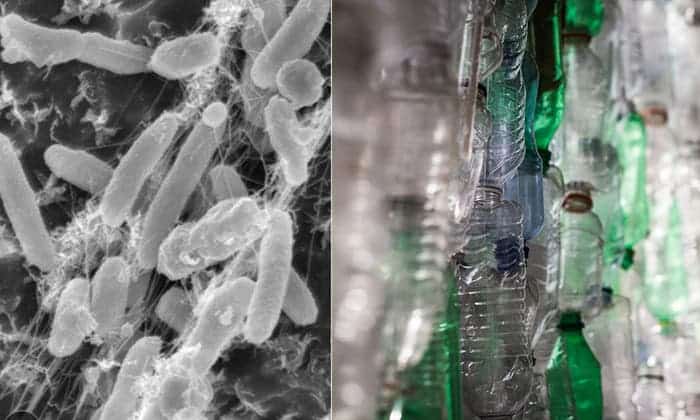Japanese researchers have identified a bacteria that eats PET, a kind of plastic widely employed for bottles. This is the first time such an organism has been found, and others like it — maybe more versatile in their preference for plastic — might be found.

The deonella sakaiensis bacteria (left) has evolved to eat plastic. Credit: Science // Wikimedia Commons
About 50 million tons of Polyethylene terephthalate (PET) are made each year to satisfying our growing needs for fabrics, electrics and beverage containers. Alas, half of all PETs end up either in land fills or the ocean.
PET is notoriously difficult to break down due to its very strong hydrocarbon bonds. Somehow, the unceremoniously named bacteria, Ideonella sakaiensis 201-F6, has found a way to devour PET. It’s remarkable when you consider PET hasn’t been around for that long, only a couple of decades. This goes to show just how adaptable bacteria are. Leave them to their own devices and only one food stock, and they’ll find a way to feed on it.
Shosuke Yoshida and colleagues collected and analyzed 250 PET samples of various quality from a PET bottle recycling facility. Many of the samples were covered in sediments, soil, wastewater or activated sludge. Invariably, organisms lurked about, among them our bacteria with an appetite for the petroleum-derived plastic.
The bacteria takes it time, devouring a PET bottle in about six weeks. Using two unique enzymes, the bacteria breaks down PET to its major constituting compounds — ethylene glycol and terephthalic acid. With some genetic tweaks, though, this process could be significantly boosted, the authors report in the journal Science.
Since the bacteria has only been recently described, its tentative applications are still being explored. Of course, waste management immediately comes to mind but it may not be that simple. Many PET bottles contain additives which are toxic. By breaking down the PETs by spraying landfills or oceans with the bacteria we may be doing more harm than good. This needs to be thoroughly studied.
“The discovery of PET-devouring bacteria is encouraging scientific progress that should be flanked by replacing present-day plastics with greener, more sustainable alternative materials,” said Rolf Halden, a professor and director of the Center for Environmental Security at Arizona State University.
Even if this bacteria or others like it lurking in landfills can solve part of our plastic waste problem, in the end it’s also our responsibility to properly manage the waste. For one, we need to recycle more. Secondly, we need to use non-petroleum derived plastics. Just the other day I reported how researchers are experimenting with a PET-like material made from CO2, carbonate and agricultural waste compounds. The end result is a renewable and more environmentally friendly product. Nothing is in vain.









